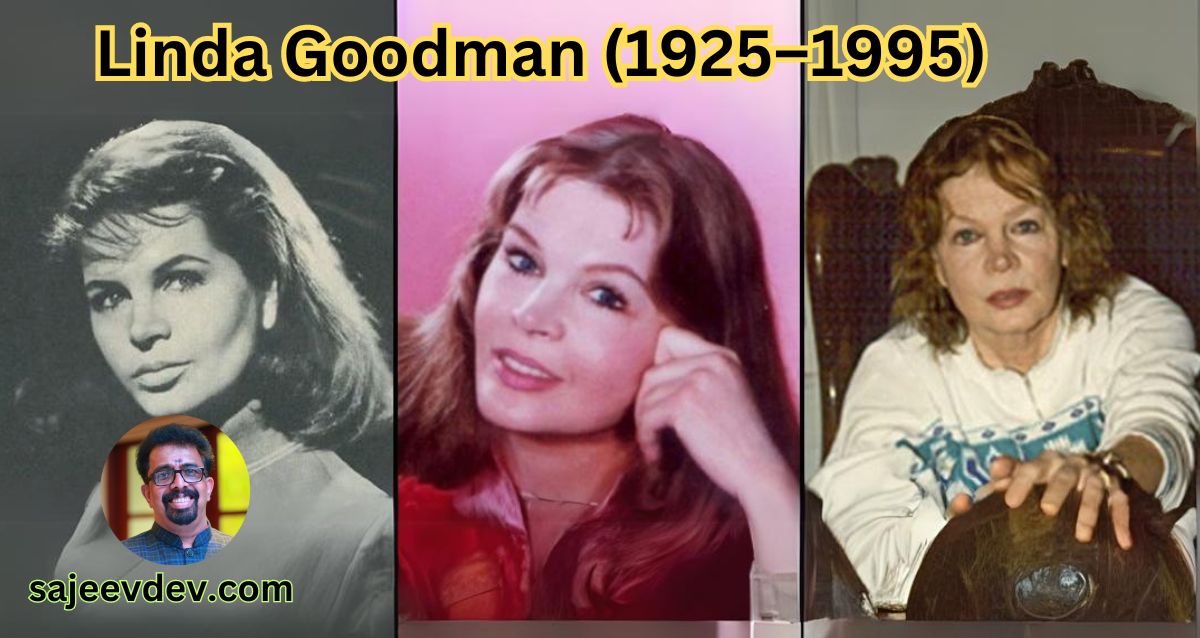Linda Goodman
Born on April 9, 1925, Linda Goodman emerged as a notable figure in the realm of astrology, making profound contributions that would shape modern astrological thought and its accessibility to the general public. Raised in a family that cultivated both creativity and intellectual curiosity, she developed early interests in poetry and philosophy, both of which would later influence her astrological writings. Goodman completed her schooling in the United States, where she exhibited a talent for writing that would pave the way for her future career.
Goodman initially embarked on a path in journalism, utilizing her skills to explore various topics. However, it was her fascination with astrology that ultimately defined her career. During a time when astrology was largely considered a niche interest, Goodman recognized its potential to connect with a broader audience. Her pioneering spirit led her to revive ancient astrological knowledge, making it relatable to everyday life. This was a time when the United States was undergoing significant social change, and Goodman’s work resonated with many seeking guidance and understanding through the stars.
Goodman published her first major work, “Linda Goodman’s Sun Signs,” in 1968, which became an instant bestseller. This book demystified astrology and provided readers with insightful personality profiles based on their sun signs, appealing to both seasoned enthusiasts and novices alike. This groundbreaking approach marked the beginning of her influential journey in popularizing astrology across America. Her ability to weave personal anecdotes, poetic expressions, and astrological wisdom together not only broadened the appeal of astrology but also established her as an authority in the field. Linda Goodman’s impactful legacy continues to inspire countless individuals today, leaving an indelible mark on Western culture.
The Birth of ‘Sun Signs’
Linda Goodman’s ‘Sun Signs’, published in 1968, marked a transformative moment in the field of astrology. Motivated by her desire to demystify astrology for the general public, Goodman sought to create a text that was accessible, engaging, and informative. Unlike traditional astrological writings, which often featured complex terminology and were primarily directed toward experienced practitioners, ‘Sun Signs’ presented astrology in a more relatable manner, focusing on the twelve zodiac signs and their influence on personality traits and behaviors.
The book’s unique format combined concise descriptions of each zodiac sign with practical insights into how these traits manifest in everyday life. Goodman’s approachable writing style captivated readers, allowing them to connect with the material on a personal level. Her emphasis on sun signs rather than the more elaborate astrological charts made it easier for individuals to identify and understand their astrological profile, effectively broadening the audience for astrological literature.
Upon its release, ‘Sun Signs’ garnered significant attention, quickly becoming a bestseller. The public reception was overwhelmingly positive, with many readers praising the book for its clarity and relatability. This marked a pivotal shift in how astrology was perceived, transforming it from an esoteric practice to a popular form of entertainment and self-exploration. Goodman’s work sparked interest in astrological studies, launching a renewed cultural fascination with zodiac signs.
Ultimately, ‘Sun Signs’ paved the way for a new generation of astrology enthusiasts. By breaking down the complexities of astrological concepts into digestible formats, Goodman played a crucial role in shaping the modern landscape of astrology, making it available and appealing to the masses. This pioneering book not only solidified her legacy but also established a foundation for the growing acceptance of astrology in contemporary society.
Astrology’s Rise in Popular Culture
During the 1960s, astrology experienced a significant transformation from a niche interest to a widespread cultural phenomenon, largely facilitated by the impactful writings of Linda Goodman. Her seminal work, “Sun Signs,” published in 1968, provided the first comprehensive guide to astrology tailored for the everyday reader. Goodman’s dynamic prose and accessibility resonated with a generation eager for self-discovery amid the tumultuous changes of the time. The counterculture movement, characterized by a quest for personal enlightenment and an embrace of alternative lifestyles, created an environment ripe for the acceptance of astrology.
As society moved away from traditional norms and engaged in a broader exploration of spirituality and self-awareness, Goodman’s work emerged as a beacon for those seeking to understand themselves and their relationships better. Her engaging style demystified astrological concepts, presenting them not just as divinations but as tools for introspection and personal growth. The growing fascination with metaphysics, paired with the upheavals in societal values, set the stage for astrology to flourish as an essential component of popular culture.
Throughout the 1960s, astrology began appearing outside specialized circles, infiltrating literacy and media in unprecedented ways. Goodman’s ability to present astrology with clarity and charm contributed significantly to this surge in popularity. Newspapers and magazines started to feature astrological columns, while the youth-oriented music and art of the era drew upon astrological themes. This broader cultural embrace cemented astrology’s position as both a vehicle for self-exploration and a means of connecting with a community of like-minded individuals. Through her groundbreaking approach, Goodman helped astrology gain traction as a legitimate form of inquiry, ensuring its enduring legacy in popular culture.
Writing Style and Approachability
Linda Goodman revolutionized the field of astrology with her distinctive writing style and approachable manner, which endeared her to a broad audience. Unlike many of her contemporaries, who often communicated in esoteric jargon, Goodman adopted a clear and relatable language that allowed readers from various backgrounds to grasp the principles of astrology. This accessibility was largely attributed to her belief that astrology should not be cloaked in complexity but rather presented as a tool for personal growth and understanding.
One of the hallmark features of Goodman’s writing was her use of personal stories, which imbued her astrological discussions with warmth and authenticity. By sharing anecdotes from her own life and the experiences of those she encountered, she created a narrative that resonated with readers, inviting them to view astrology not only as an academic study but as a practical guide to navigating life’s challenges. Her ability to blend personal experience with astrological insight fostered a sense of intimacy between her and her readers, enhancing their engagement with the subject matter.
In addition to storytelling, Goodman’s incorporation of humor into her writing made the subject more enjoyable and relatable. She often used wit to address serious themes, demystifying astrological concepts that might otherwise seem daunting. This playful approach not only made her work accessible but also offered solace, making astrology an inviting refuge for those seeking guidance.
Consequently, Linda Goodman’s unique writing style and approachability established her as a leading figure in modern astrology. Her work transcended niche interest, allowing astrological ideas to permeate mainstream culture. By breaking down complex astrological principles into familiar language and offering a slice of her life, Goodman left an indelible mark, ensuring that astrology remained a warm, inviting realm for all.
Impact on Western Astrology
Linda Goodman’s contributions to astrology have left an indelible mark on the landscape of Western astrology. Her approachable and engaging style of writing played a crucial role in demystifying the discipline, which had often been viewed as esoteric and reserved for a select few. Goodman’s seminal work, “Sun Signs,” published in 1968, introduced astrology to a mainstream audience, allowing both amateur enthusiasts and seasoned professionals to explore celestial influences in a more accessible manner. This text provided an entry point for many individuals curious about astrology, sparking a broader interest in astrological studies.
Goodman’s ability to blend astrological accuracy with easy-to-understand language allowed her to reach a diverse audience. The focus on the Sun sign system, which correlates to one’s birth date, simplified astrology for novices, making it easier for them to comprehend their personal charts and the traits associated with different signs. This interpretative technique not only enhanced the appeal of astrology but also encouraged individuals to delve deeper into their astrological understanding, seeking knowledge about moon signs, rising signs, and planetary positions.
The popularity of Goodman’s work also catalyzed a significant increase in the number of aspiring astrologers, resulting in a surge of interest in learning about astrology through formal education and self-study. Many professional astrologers cite Goodman as an influence in their journey, either through her books or her innovative methodologies. Furthermore, her emphasis on combining astrology with psychological insights contributed to the establishment of humanistic astrology, a branch that focuses on personal growth and self-awareness through astrological interpretation. Consequently, Goodman not only shaped the practice of astrology but also enhanced its acceptance as a valuable tool for self-discovery and personal development.
Life After ‘Sun Signs’ and Other Works
Following the monumental success of “Sun Signs,” Linda Goodman continued to solidify her status as a preeminent figure in the realm of astrology through her subsequent works. “Love Signs,” published in 1986, marked a significant expansion of her teachings, delving deeper into the complexities of astrological compatibility in relationships. In this book, Goodman introduced readers to the nuances of pairing sun signs, enhancing their understanding of how different personalities interact based on their astrological configurations. It not only showcased her practical approach to astrology but also illustrated her belief that knowledge of astrological principles could significantly enrich personal relationships.
Another noteworthy contribution is “Linda Goodman’s Star Signs,” released in 1987. This work elevated her teachings by integrating metaphysical principles with astrology, allowing readers to explore a broader spectrum of spiritual and cosmic influences. Goodman’s exploration of numerology and tarot alongside astrology demonstrated her desire to connect various esoteric systems, emphasizing the interconnectedness of the universe. This holistic approach drew in a diverse audience, further entrenching her legacy as a pioneer who made astrology accessible to the masses.
Goodman’s prolific writing style, characterized by its engaging and relatable tone, significantly contributed to her growing following. She communicated complex astrological concepts in a manner that resonated with everyday readers, thus inviting them into the world of astrology without alienation. The popularity of her works post-“Sun Signs” not only brought astrology into mainstream discourse but also asserted Goodman’s role as a key figure in making astrological wisdom a tool for self-improvement and understanding relationships.
Criticism and Controversies
Linda Goodman, a renowned figure in the world of astrology, has faced a fair share of criticism and controversy surrounding her methodologies and claims. As a pioneer who sought to popularize astrology for the masses, Goodman’s work drew both admiration and skepticism. Critics often categorize astrology itself as a pseudoscience, arguing that it lacks empirical support and relies heavily on anecdotal evidence. This skepticism was particularly aimed at Goodman, given her assertive promotion of astrology as a tool for personal growth and life guidance.
Goodman’s most notable work, “Sun Signs,” reached a wide audience, leading some detractors to argue that her interpretations oversimplified the complexities of astrological practices. They contended that such simplification could lead individuals to naively rely on astrological insights, potentially affecting significant life decisions based on vague generalizations. Skeptics also pointed to inconsistencies and unfounded claims in her astrological forecasts as evidence of the limitations inherent in her approach.
In response to critiques, Goodman upheld her beliefs with passion, maintaining that astrology, when understood properly, offers profound insights into human behavior and relationships. She often noted that the practice should not solely be judged by scientific standards but rather through personal experiences and anecdotal evidence, which she deemed equally valid. Her popularization of astrology served not only as a means of guidance but also as a point of contention within the broader discourse surrounding its place in modern society.
The dichotomy between her widespread appeal and the critical lens through which astrology is viewed highlights the ongoing debate regarding the legitimacy of astrological claims. Goodman’s legacy, therefore, remains complex; while she garnered significant followers who embraced her teachings, she also faced substantial backlash from those who view astrology as lacking scientific rigor.
Goodman’s Legacy and Influence Today
Linda Goodman, a notable figure in the realm of astrology, left a profound impact that persists to this day. Her groundbreaking work, particularly the popularization of astrology through accessible language and relatable content, shifted the perception of astrological practices from niche to mainstream. Goodman’s books, particularly “Sun Signs” and “Love Signs,” introduced astrological concepts to a wider audience, effectively democratizing this ancient discipline. Her approach combined personal anecdotes with astrological interpretations, making the subject approachable for those who may have previously been skeptical of astrology.
Today, Goodman’s influence can be seen in the resurgence of interest in astrology, especially among younger demographics. This renewed curiosity is evidenced by the proliferation of social media platforms where astrology-related content flourishes. Many contemporary astrologers and writers cite Goodman as a source of inspiration, often echoing her techniques of weaving personal stories with astrological insights. The blend of psychology and astrology that Goodman championed is particularly relevant in today’s fast-paced world, where individuals seek guidance and understanding within their lives.
Furthermore, the growth of astrological apps and online resources has brought a new dimension to Goodman’s legacy. Modern practitioners utilize technology to explore and interpret astrology, leaning on Goodman’s foundational work to bridge the gap between traditional practices and contemporary methods. This adaptation signifies that Goodman’s principles continue to resonate, ensuring her influence in astrological circles remains robust.
As astrology evolves, Linda Goodman’s legacy serves as a cornerstone, encouraging personal exploration and enhancing the understanding of celestial influences on individual lives. By fostering such insights and interpretations, Goodman has undeniably shaped how astrology is practiced and perceived in today’s society, ensuring her enduring relevance in this timeless field.
The enduring allure of astrology can be observed through its sustained popularity across different cultures and generations
The enduring allure of astrology can be observed through its sustained popularity across different cultures and generations. As a complex blend of ancient wisdom and contemporary interpretation, astrology offers individuals a unique lens through which to explore the intricacies of life and self. This practice, which points to the influence of celestial bodies on human behavior and events, has captivated countless seekers who look to the stars for guidance. Linda Goodman’s pivotal contributions in the late 20th century have undoubtedly played a significant role in this ongoing fascination.
Goodman was not merely a proponent of astrology; she was a visionary who transformed the field into a mainstream pursuit. Her bestselling books, such as “Sun Signs” and “Love Signs,” made astrology more accessible, demystifying complex astrological concepts and inviting a wider audience to partake in this ancient art. By weaving in psychological insights and personal anecdotes, Goodman established a relatable approach that resonated deeply with readers, thereby solidifying astrology’s cultural relevance. Her legacy persists, demonstrating that astrology transcends mere prediction; it serves as a tool for self-reflection and personal growth.
As individuals increasingly seek spiritual avenues for understanding their identities and relationships, astrology remains a valuable resource. It encourages introspection and fosters a sense of connection, not only to oneself but also to the larger universe. Engaging with astrology offers the opportunity to explore the nuances of human experience, from relationships to life choices, enhancing the journey of self-discovery. Thus, as we reflect on Goodman’s profound impact, it becomes evident that astrology will likely continue to inspire and inform personal journeys for years to come.



